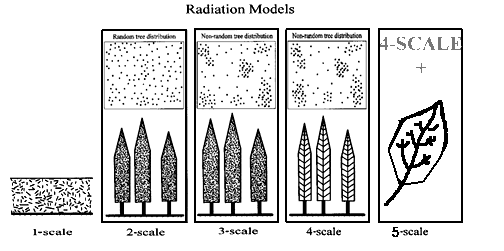5-Scale is a combination of 4-Scale
by Chen
and Leblanc (1997) and LIBERTY
by Dawson
et al. (1998). It's main goal is to compute the reflectance
of a vegetated surface from the remote sensing point of view.
5-Scale is geometric-optical radiative-transfer
model that was developed with emphasis on the structural
composition of forest canopies at different scales. Although
developed for boreal forest applications [2],
it can be applied to other types of vegetation.
5-Scale employs the following methodologies:
(1) The model simulates tree crowns as discrete geometrical
objects: cone and cylinder for conifers, and spheroid for
deciduous species. The non-random spatial distribution of
trees is simulated using the Neyman (1939)
type A distribution that creates patchiness of a forest stand.
The size of the crowns decreases when the trees are found
in large clusters and the tree locations can also be subject
to a repulsion effect (i.e., no vertical overlaps occur) to
better represent the competition for light;
(2) Inside the crown, a branch architecture defined by a
single inclination angle is included (Chen
and Black, 1991). A branch is in turn composed of foliage
elements (individual leaves in deciduous and shoots in conifer
canopies) with a given angle distribution pattern;
(3) The hotspot
is computed both on the ground and on the foliage with gap
size distributions between and inside the crowns, respectively;
(4) The tree surface created by the crown volume (cone and
cylinder, or spheroid) is treated as a complex medium rather
than a smooth surface so that shadowed foliage can be observed
on the sunlit side and sunlit foliage on the shaded side.
(5) A multiple scattering scheme using view factors is used
to compute the "shaded reflectivities."
(6) If canopy and background spectra are available, 5-Scale
can output the bidirectional hyperspectral reflectance at
any combination of sun and view geometries. The default input
format for the foliage spectrum corresponds to the LIBERTY
model by Dawson et al.(1998). LIBERTY is part of 5-Scale and
can be used to simulate foliage reflectivity based on chlorophyl,
water content, etc. A few measured spectra are also given
with 5-Scale.

Scales of plant canopy architecture considered in reflectance
models:
- 1-scale: turbid media;
- 2-scale: randomly distributed discrete objects containing
turbid media;
- 3-scale: non-random discrete objects containing turbid
media;
- 4-scale: non-random discrete objects with internal structures
(such as branches and shoots).
- 5-scale: 4-Scale + radiation transfer inside the foliage
is considered
|